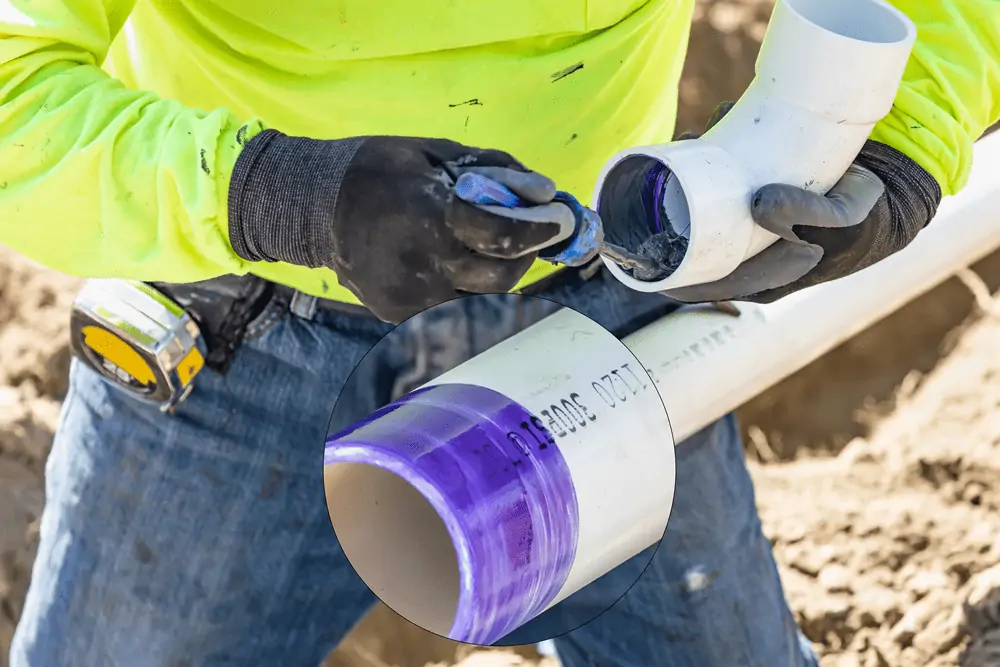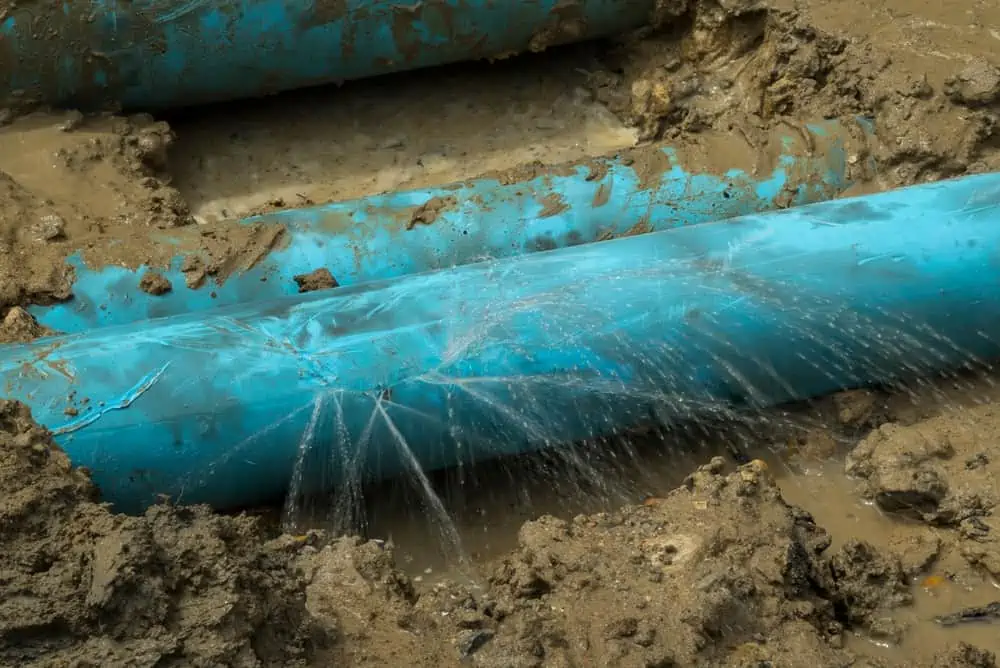Pressure ratings for PVC (Polyvinyl Chloride) pipe are based on the ability of the material to resist stress. The maximum operating pressure is dependent on nominal pipe size, thickness (schedule), service temperature, and method used to join pipe segments.
PVC pipe fittings have their pressure ratings determined similarly, but frequently are different than rating of the piping. The system design must ensure all components are within their rated pressure capacity.
Where Are PVC Pipe Pressure Ratings Found?
The pressure ratings for PVC piping can be found in standards such as ASTM D1785 (Standard Specification for PVC Pipes). These standards also outline maximum temperature limits and values for de-rating allowable pressure as temperatures rise. Generally, as the nominal pipe size becomes larger the maximum service pressure is lower.
The ASTM standard outlines the design hydrostatic stresses for each pressure rating. In the case of piping with thicker walls, such as schedule 80 or 120, different ratings are specified for the pipe if it will be used in a threaded connection or a solvent cemented connection.


Elevate Your Engineering With Excel
Advance in Excel with engineering-focused training that equips you with the skills to streamline projects and accelerate your career.
Internationally, ratings and limits are found in standards such as ISO/TC 138 (Plastic Pipes, Fittings, and Valves). These ASTM or ISO standards are normally given legal authority once incorporated into codes such as ASME B31.9 (Building Services Piping) or the International Building Code.
Because of the complexity standards such as ASTM D1785, simplified tables are provided by the pipe manufacturer for the specific grade of the product in question. An example of one of these tables is below. However, the maximum service pressure at 73°F (23°C) is always stamped onto the pipe itself.
PVC Schedule 40 Pressure Ratings @ 73 °F
| wdt_ID | Size (inch) | Pipe (psi) | Socket Fitting (psi) | Threaded Fitting (psi) | Flange (psi) | Union (psi) |
|---|---|---|---|---|---|---|
| 1 | 0.50 | 600 | 360 | 300 | 150 | 235 |
| 2 | 0.75 | 480 | 288 | 240 | 150 | 235 |
| 3 | 1.00 | 450 | 270 | 225 | 150 | 235 |
| 4 | 1.25 | 370 | 222 | 185 | 150 | 235 |
| 5 | 1.50 | 330 | 198 | 165 | 150 | 235 |
| 6 | 2.00 | 280 | 168 | 140 | 150 | 235 |
| 7 | 2.50 | 300 | 180 | 150 | 150 | 0 |
| 8 | 3.00 | 260 | 156 | 130 | 150 | 235 |
| 9 | 4.00 | 220 | 132 | 110 | 150 | 0 |
| 10 | 5.00 | 190 | 114 | 95 | 0 | 0 |
| 11 | 6.00 | 180 | 180 | 90 | 150 | 0 |
| 12 | 8.00 | 160 | 96 | 80 | 150 | 0 |
| 13 | 10.00 | 140 | 84 | 70 | 150 | 0 |
| 14 | 12.00 | 130 | 78 | 65 | 150 | 0 |
| 15 | 14.00 | 130 | 78 | 65 | 0 | 0 |
| 16 | 16.00 | 130 | 78 | 65 | 0 | 0 |
What is PVC?
PVC is a thermoplastic polymer that softens at elevated temperatures and hardens as it cools. As noted above, this property is why the allowable service pressure of PVC piping must be lowered as temperatures rise.
Aside from a common piping material, PVC is used for many other building materials, such as window frames, wiring insulation, and vinyl siding.
PVC is a widely available plastic that has been in use for decades due to its durability, low cost, and ease of installation. Construction of piping systems normally uses solvent cement joints or threaded connections. PVC pipe can be cut with common tools.
What Do The Markings On PVC Pipe Mean?
PVC pipe is labeled on the external surface by the manufacturer to provide the following information:
- The manufacturer’s name
- Country of manufacture
- Nominal size and thickness (schedule)
- Maximum pressure rating at 73°F (23°C)
- Material information code
- Additional information depending on intended usage (for example, potable water certifications)
Temperature Correction Factors for PVC Pipe
Because PVC softens as it heats up, the allowable pressure decreases as temperature increases. Therefore, its pressure rating must be derated, accounting for the maximum operating temperature.
Temperature Correction Factors
| wdt_ID | Operating Temperature (°F) | PVC | CPVC |
|---|---|---|---|
| 1 | 73 | 1.000 | 1.000 |
| 2 | 80 | 0.880 | 1.000 |
| 3 | 90 | 0.750 | 0.910 |
| 4 | 100 | 0.620 | 0.820 |
| 5 | 110 | 0.500 | 0.770 |
| 6 | 120 | 0.400 | 0.650 |
| 7 | 130 | 0.300 | 0.620 |
| 8 | 140 | 0.220 | 0.500 |
| 9 | 150 | 0.470 | |
| 10 | 160 | 0.400 | |
| 11 | 170 | 0.320 | |
| 12 | 180 | 0.250 | |
| 13 | 200 | 0.200 | |
| Operating Temperature (°F) | PVC | CPVC |
PVC has a maximum operating temperature of 140°F (60°C). At this maximum temperature, the allowable stresses are only 22% of the values at 73°F (23°C).
How Do PVC Pipes Fail?
PVC piping systems, such as potable water supply in a building, are maintained pressurized continuously. The pressure ratings for plastic pipe materials are therefore based on extended pressure conditions. Typical industry practice is to test piping to ensure a service life greater than 50 years. PVC pipes manufactured as early as the 1930s have been found in continuous use.
Plastic pipes primarily fail from physical damage. This can include failure of poorly installed connections, impact damage to exposed pipes, or freeze damage. While PVC pipes are ductile and flexible, they are susceptible to rapid stress increases, such as water hammer.

PVC does not rapidly degrade in sunlight, but without protection will become brittle and pitted.
Alternative Plastic Piping Materials
The wide-range of established plastic piping materials provides alternatives to PVC that balance attributes cost, chemical resistance, pressure rating, temperature limits, and ease of installation.
ABS – (Acrylonitrile Butadiene Styrene)
ABS is a thermoplastic known for high impact strength. ABS has similar heat stability compared to PVC. Applications where ABS is a common alternative to PVC piping are for systems associated with sewage piping and venting.
CPVC – (Chlorinated Polyvinyl Chloride)
CPVC involves an additional chemical process performed on PVC resulting in additional chlorination. The resulting plastic shares many characteristics as conventional PVC, but is more flexible, resistant to physical damage, and can withstand higher temperatures. CPVC is also used in fire suppression systems, while PVC is not.
PE – (Polyethylene)
PE is a flexible plastic that is available in lengths of straight pipe as well as large coils. For applications requiring long runs of piping, such as lawn sprinkler systems, PE allows easier installation and fewer joints compared to PVC.
PEX – (Cross-linked Polyethylene)
PEX is a molecularly cross-linked version of PE, resulting in higher strength and better heat resistance. PEX is an ideal material for hot and cold water distribution due to its durability. Because it is normally shipped in rolls, the flexible piping can be routed through buildings with fewer fittings than rigid PVC. For hot water heating systems, such as hot water baseboard or radiant floor heating, PEX is the preferred choice.
The added flexibility of PEX makes it more resistant to freeze damage than PVC. While PVC piping is normally connected by solvent cemented joints, PEX joints are normally by mechanical means such as metal crimps over barbed connections. Solvent cemented joints require time to set, whereas crimped PEX joints can be pressurized for testing immediately.
While PVC is available in various sizes, PEX is only available in smaller diameters. PEX allows hot and cold water piping to be quickly run with fewer fittings and joints.

Finding Maximum Service Pressure Of PVC Pipe
A public pool is installing a water heater connected to PVC pipe. The nominal pipe size is 4” schedule 40. All joints will be socket fittings. The heater has a tempering valve that will maintain discharge temperature below 130°F. What is the maximum allowable service pressure?
As noted above, the maximum pipe pressure ratings and temperature de-rating values can be found in ASTM D1785 for a range of PVC material grades. In the case of 4” Schedule 40 at 73°F water pressures can range from 110 to 220 psi depending on the specific PVC material.
At a temperature of 130°F, the allowable pressure must de-rated using a correction factor of 0.30. The end result it a range of allowable pressures from 33 psi to 66 psi. Note that this value is for the pipe alone, not including the fittings.
Using pressure ratings provided by a manufacturer, their specific product grade is rated at 220 psi at 73°F. Their socket fittings are rated at 132 psi at 73°F. At this service temperature, the pipe maximum pressure is 66 psi, but the socket fittings are only rated to 39.6 psi.
The maximum allowable service pressure must remain below 39.6 psi in this scenario.
